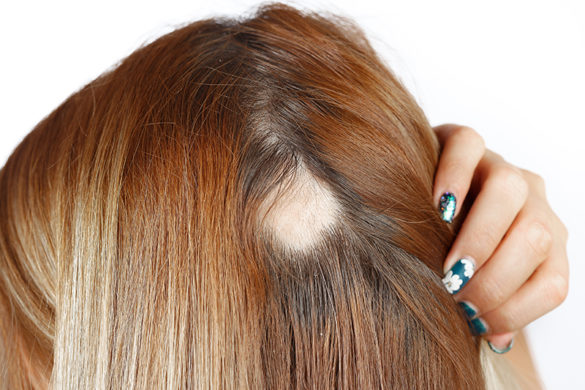If you are experiencing hair loss (aka alopecia), whatever your age, it’s best to see a specialist as soon as possible. Dermatologists are experts in diagnosing and treating hair loss. A dermatologist can often diagnose the precise type of alopecia, of which there are 10-15 different varieties.
It’s best to make a hair loss consultation with a dermatologist at the first sign of hair loss. There is treatment which can prevent hair loss from worsening, but the sooner treatment is received the better the result for most types of hair loss.
 What is hair loss?
What is hair loss?
Hair loss in both men and women of all ages is quite a common condition, although the results can be very traumatic. Alopecia is the technical term for hair loss but diagnosing the right type of alopecia is crucial in helping to pick the most effective treatment.
Alopecia Areata – This often starts with patchy hair loss and is thought to be an autoimmune condition, with cells attacking the follicle to stop it from producing more hair. Although why this happens is not yet understood, you can lose patches on the scalp and/or across the body from beards, eyebrows, eyelashes, and body hair.
Androgenetic Alopecia (Pattern Hair Loss) – Male and female pattern hair loss causes hairs to fall out in a well-defined pattern in men. In women, the hair becomes thinner over the parting rather than receding from the temples.
Central Centrifugal Cicatricial Alopecia (Scarring Alopecia) – Primary scarring alopecias or scarring hair loss are conditions that destroy the hair follicle and replace it with scar tissue. This scarring causes permanent hair loss and starts in the centre of the patch and slowly spreads out. Other scarring alopecias include Frontal Fibrosing Alopecia (FFA) and Lichen Planopilaris, which usually affects women rather than men.
Telogen Effluvium – More hairs than usual move into the telogen (resting) phase and shed, so you may notice more hair falling out than usual, this is often caused by a physical trigger or deficiency and can resolve itself provided the trigger is removed or the deficiency corrected
Traction Alopecia – This is caused when hair falls out because it has been pulled in the same way for a long time. It is usually caused by tight hairstyles or ponytails, as well as hair relaxers and extensions.
How do dermatologists diagnose the cause of hair loss?
Your dermatologist has a variety of methods available to diagnose the cause of hair loss. Sometimes no tests are required, and treatment can be started immediately.
Hair pull test – With the right amount of tension, only a certain number of hairs can be pulled from the root with little discomfort. This is called the hair pull test and its results guide dermatologists in navigating towards a diagnosis.
Dermoscopy/Trichoscopy – This is a specialised and magnified view of the hair follicles with a piece of equipment called a dermatoscope. Specialists can identify particular features in the hairs and hair follicles which are found in some conditions but not in others.
Blood tests – Based on the history and story behind the hair loss, dermatologists specialise in knowing the precise blood tests to check, that could reveal the cause of what might be driving hair loss.
Biopsy – In some cases, a 4mm biopsy (4mm piece of skin) is taken to be analysed by a pathologist under the microscope. This is another step towards identifying the reaction patterns that may be causing the hair loss if the picture is not completely clear.
How can a dermatologist treat hair loss?
We all lose between 50 and 100 hairs every day, and while hair loss is not usually anything to be worried about, occasionally it can be a sign of a medical condition. Hair loss usually runs in the family for both men and women, and can be caused by an illness, rapid weight loss, malabsorption, or dietary deficiency.
Over the last 10 years there have been some excellent advances in treating thinning hair and hair loss. Although some forms of hair loss recover on their own, the scarring types don’t recover well. This is why it is very important to diagnose these as quickly as possible to control the condition as early as possible and minimise the overall hair loss.
Once you have a diagnosis from a dermatologist as to what type of hair loss you are experiencing, there are treatments available in the forms of creams, injections, and tablets. Most are only on prescription, with specialist administration which can be provided by a dermatologist.
Common treatments for Alopecia Areata include corticosteroids, designed to dampen down the immune response and topical immunotherapy to distract the immune response.
For further advice and information on hair loss and hair problems from an expert dermatologist, contact Diamond Skin Care on 01603 298396 or book a hair loss consultation.


